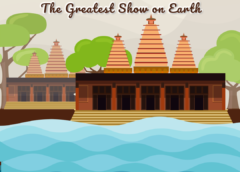Kumbh Mela or Kumbha Mela (/ËŒkÊŠm ˈmeɪlÉ™/ or /ËŒkÊŠm məˈlÉ‘Ë/), inscribed on the UNESCO’s Representative List of Intangible Cultural Heritage of Humanity, is a mass Hindu pilgrimage of faith in which Hindus gather to bathe in a sacred or holy river. Traditionally, four fairs are widely recognized as the Kumbh Melas: the Haridwar Kumbh Mela, the Allahabad Kumbh Mela, the Nashik-Trimbakeshwar Simhastha, and Ujjain Simhastha. These four fairs are held periodically at one of the following places by rotation: Haridwar, Allahabad (Prayaga), Nashik district (Nashik and Trimbak), and Ujjain. The main festival site is located on the banks of a river: the Ganges (Ganga) at Haridwar; the confluence (Sangam) of the Ganges and the Yamuna and the invisible Sarasvati at Allahabad; the Godavari at Nashik; and the Shipra at Ujjain. Bathing in these rivers is thought to cleanse a person of all the sins.
At any given place, the Kumbh Mela is held once in 12 years. There is a difference of around 3 years between the Kumbh Melas at Haridwar and Nashik; the fairs at Nashik and Ujjain are celebrated in the same year or one year apart. The exact date is determined, as per Vikram Samvat calendar and the principles of Jyotisha, according to a combination of zodiac positions of the Jupiter, the Sun and the Moon. At Nashik and Ujjain, the Mela may be held while a planet is in Leo (Simha in Hindu astrology); in this case, it is also known as Simhastha. At Haridwar and Allahabad, an Ardha (“Half”) Kumbh Mela is held every sixth year; a Maha (“Great”) Kumbh Mela occurs after 144 years.
The priests at other places have also claimed their local fairs to be Kumbh Melas. For example, the Mahamaham festival at Kumbakonam, held once in 12 years, is also portrayed as a Kumbh Mela.
The exact age of the festival is uncertain. According to medieval Hindu mythology, Lord Vishnu dropped drops of Amrita (the drink of immortality) at four places, while transporting it in a kumbha (pot). These four places are identified as the present-day sites of the Kumbh Mela. The name “Kumbh Mela” literally means “kumbha fair”. It is known as “Kumbh” in Hindi (due to schwa deletion); in Sanskrit and some other Indian languages, it is more often known by its original name “Kumbha”.
The festival is one of the largest peaceful gatherings in the world, and considered as the “world’s largest congregation of religious pilgrims”. There is no precise method of ascertaining the number of pilgrims, and the estimates of the number of pilgrims bathing on the most auspicious day may vary. An estimated 120 million people visited Maha Kumbh Mela in 2013 in Allahabad over a two-month period,[7] including over 30 million on a single day, on 10 February 2013 (the day of Mauni Amavasya)

Leave a Reply
You must be logged in to post a comment.